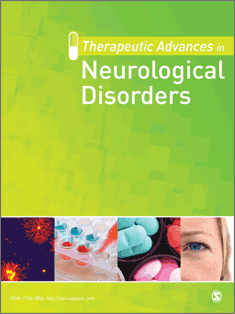延长时间窗内治疗急性缺血性脑卒中的替奈普酶:系统综述和荟萃分析
IF 4.7
2区 医学
Q1 CLINICAL NEUROLOGY
引用次数: 0
摘要
背景:有关在延长时间窗内对急性缺血性卒中(AIS)患者使用替奈普酶(TNK)的结果数据有限。目的:我们旨在评估目前有关替奈普酶疗效的证据:我们的目的是评估目前有关 0.25 mg/kg 剂量的 TNK 在延长时间窗治疗 AIS 的有效性和安全性的证据。设计:我们进行了一项系统性回顾和荟萃分析,包括所有可用的随机对照临床试验(RCT),这些试验比较了 TNK 0.25 mg/kg 与不溶栓治疗在延长时间窗(最后一次见井或目击发病后 >4.5 小时)出现的 AIS 患者的效果。数据来源和方法:通过检索 Medline、Scopus 和国际会议摘要确定符合条件的研究。预定义的疗效结果为 3 个月的极佳功能结果[定义为改良 Rankin 量表(mRS)评分⩽1;主要结果]、3 个月的良好功能结果(mRS ⩽2)、3 个月的残疾程度降低(所有 mRS 评分均降低⩾1 分)。我们将症状性颅内出血(sICH)、任何 ICH 和 3 个月死亡率作为安全性终点。我们采用随机效应模型计算风险比 (RR) 和常见几率比 (cOR),并得出相应的 95% 置信区间 (CI)。结果:共纳入三项研究,包括556名接受TNK治疗的患者和560名对照组患者。与对照组相比,TNK 0.25 mg/kg与3个月的优良功能预后相关(RR = 1.17;95% CI = 1.01-1.36;I2 = 0%),而在3个月的优良功能预后(RR = 1.05;95% CI = 0.94-1.17;I2 = 0%)和残疾减少(调整后的cOR = 1.14;95% CI = 0.92-1.40;I2 = 0%)方面没有差异。各组间发生 sICH(RR = 1.67;95% CI = 0.70-4.00;I2 = 0%)、任何 ICH(RR = 1.08;95% CI = 0.90-1.29;I2 = 0%)和 3 个月死亡率(RR = 1.10;95% CI = 0.81-1.49;I2 = 0%)的风险相似。结论根据三项 RCT 的数据显示,TNK 在延长时间窗内治疗 AIS 的疗效增强,安全性良好,因此该领域正在进行的 RCT 显然得到了支持。试验注册:PROSPERO 注册号:CRD4202344870CRD42023448707。本文章由计算机程序翻译,如有差异,请以英文原文为准。
Tenecteplase for the treatment of acute ischemic stroke in the extended time window: a systematic review and meta-analysis
Background: Outcome data regarding the administration of tenecteplase (TNK) to acute ischemic stroke (AIS) patients presenting in the extended time window are limited. Objectives: We aimed to assess the current evidence regarding the efficacy and safety of TNK at a dose of 0.25 mg/kg for AIS treatment in the extended time window. Design: A systematic review and meta-analysis was conducted including all available randomized-controlled clinical trials (RCTs) that compared TNK 0.25 mg/kg versus no thrombolysis in AIS patients presenting in the extended time window (>4.5 h after last-seen-well or witnessed onset). Data sources and methods: Eligible studies were identified by searching Medline, Scopus, and international conference abstracts. The predefined efficacy outcomes of interest were 3-month excellent functional outcome [defined as the modified Rankin Scale (mRS) score ⩽1; primary outcome], 3-month good functional outcome (mRS ⩽ 2), 3-month reduced disability (⩾1-point reduction across all mRS scores). We determined symptomatic intracranial hemorrhage (sICH), any ICH and 3-month mortality as safety endpoints. A random-effects model was used to calculate risk ratios (RRs) and common odds ratios (cORs) with corresponding 95% confidence intervals (CIs). Results: Three RCTs were included comprising 556 patients treated with TNK versus 560 controls. TNK 0.25 mg/kg was associated with a higher likelihood of 3-month excellent functional outcome compared to controls (RR = 1.17; 95% CI = 1.01–1.36; I2 = 0%), whereas there was no difference regarding good functional outcome (RR = 1.05; 95% CI = 0.94–1.17; I2 = 0%) and reduced disability (adjusted cOR = 1.14; 95% CI = 0.92–1.40; I2 = 0%) at 3 months. The risks of sICH (RR = 1.67; 95% CI = 0.70–4.00; I2 = 0%), any ICH (RR = 1.08; 95% CI = 0.90–1.29; I2 = 0%) and 3-month mortality (RR = 1.10; 95% CI = 0.81–1.49; I2 = 0%) were similar between the groups. Conclusion: Based on data from three RCTs showing increased efficacy and a favorable safety profile of TNK in the treatment of AIS in the extended time window, continuing efforts of ongoing RCTs in the field are clearly supported. Trial registration: PROSPERO registration ID: CRD42023448707.
求助全文
通过发布文献求助,成功后即可免费获取论文全文。
去求助
来源期刊

Therapeutic Advances in Neurological Disorders
CLINICAL NEUROLOGY-
CiteScore
8.30
自引率
1.70%
发文量
62
审稿时长
15 weeks
期刊介绍:
Therapeutic Advances in Neurological Disorders is a peer-reviewed, open access journal delivering the highest quality articles, reviews, and scholarly comment on pioneering efforts and innovative studies across all areas of neurology. The journal has a strong clinical and pharmacological focus and is aimed at clinicians and researchers in neurology, providing a forum in print and online for publishing the highest quality articles in this area.
 求助内容:
求助内容: 应助结果提醒方式:
应助结果提醒方式:


